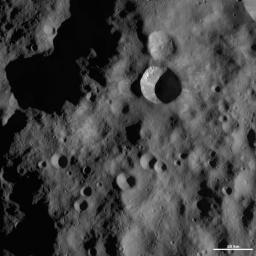This Dawn framing camera (FC) image of Vesta shows Arruntia crater, which is the large crater offset to the top right of the center of the image. Slightly over half of Arruntia crater is covered in a large shadow. But, the non-shadowed part of Arruntia shows impressive details. There is bright material cropping out slightly below the left rim and just below the top and bottom rims there are distinct ridges of material, which are probably formed by material from the rim cascading down towards the center of Arruntia. Hummocky slumps of material can be seen on the lower parts of the interior of Arruntia crater. Arruntia crater is probably one of the freshest craters in this image because it has a sharp, distinct rim and because of the range of preserved features in its interior. Younger craters tend to be the ones that have suites of features within them because not enough time has passed for the features to be erased.
This image is located in Vesta's Bellicia quadrangle, in Vesta's northern hemisphere. NASA's Dawn spacecraft obtained this image with its framing camera on Oct. 24, 2011. This image was taken through the camera's clear filter. The distance to the surface of Vesta is 700 kilometers (435 miles) and the image has a resolution of about 63 meters (207 feet) per pixel. This image was acquired during the HAMO (high-altitude mappig orbit) phase of the mission.
The Dawn mission to Vesta and Ceres is managed by NASA's Jet Propulsion Laboratory, a division of the California Institute of Technology in Pasadena, for NASA's Science Mission Directorate, Washington D.C. UCLA is responsible for overall Dawn mission science. The Dawn framing cameras have been developed and built under the leadership of the Max Planck Institute for Solar System Research, Katlenburg-Lindau, Germany, with significant contributions by DLR German Aerospace Center, Institute of Planetary Research, Berlin, and in coordination with the Institute of Computer and Communication Network Engineering, Braunschweig. The framing camera project is funded by the Max Planck Society, DLR, and NASA/JPL.
More information about Dawn is online at http://www.nasa.gov/dawn and http://dawn.jpl.nasa.gov.

 Planetary Data System
Planetary Data System












